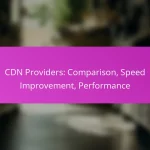What are effective cost management strategies for web application performance?
Effective cost management strategies for web application performance focus on optimizing resources while maintaining high-speed functionality. By implementing various techniques, businesses can reduce operational costs and improve user experience simultaneously.
Implementing cloud cost optimization
Cloud cost optimization involves analyzing and managing cloud resource usage to minimize expenses. This can include rightsizing instances, utilizing reserved instances, and leveraging spot instances for non-critical workloads. Regular audits of cloud spending can help identify underutilized resources that can be downsized or eliminated.
Consider using tools like AWS Cost Explorer or Azure Cost Management to track and analyze your cloud spending. These tools provide insights into usage patterns and help forecast future costs, allowing for better budget planning.
Utilizing performance monitoring tools
Performance monitoring tools are essential for identifying bottlenecks and inefficiencies in web applications. Tools like New Relic or Datadog provide real-time insights into application performance, enabling teams to quickly address issues that may lead to increased costs or degraded user experience.
Establish key performance indicators (KPIs) such as response times and error rates to measure the effectiveness of your application. Regularly reviewing these metrics can help you make informed decisions about resource allocation and cost management.
Adopting serverless architecture
Serverless architecture allows developers to build and run applications without managing server infrastructure, leading to cost savings. With a pay-as-you-go model, businesses only pay for the compute time they consume, which can significantly reduce costs for variable workloads.
Consider platforms like AWS Lambda or Azure Functions, which automatically scale based on demand. This flexibility can lead to lower operational costs, especially for applications with unpredictable traffic patterns.
Leveraging content delivery networks
Content delivery networks (CDNs) improve web application performance by distributing content closer to users, reducing latency and load times. By caching static content, CDNs can decrease the load on origin servers, resulting in lower bandwidth costs.
Popular CDN providers like Cloudflare or Akamai can help enhance user experience while managing costs effectively. Implementing a CDN can lead to significant savings, especially for applications with a global user base.
Optimizing database queries
Optimizing database queries is crucial for improving application performance and reducing costs associated with database operations. Efficient queries can minimize resource consumption and speed up response times, leading to a better user experience.
Consider indexing frequently accessed data and analyzing query performance to identify slow-running queries. Regularly reviewing and refining your database schema can also help in maintaining optimal performance and cost efficiency.
How can businesses in the US reduce web application costs?
Businesses in the US can reduce web application costs by utilizing cloud service pricing tools, optimizing resource usage, and implementing effective monitoring strategies. These methods help identify unnecessary expenses and streamline operations for better financial efficiency.
Using AWS Cost Explorer
AWS Cost Explorer is a powerful tool that allows businesses to visualize their AWS spending and usage patterns. By analyzing historical data, companies can identify trends and forecast future costs, enabling them to make informed decisions about resource allocation.
To get started, businesses should categorize their costs by service, region, and usage type. This breakdown helps pinpoint areas where savings can be achieved, such as reducing underutilized resources or switching to more cost-effective pricing plans.
Employing Google Cloud Pricing Calculator
The Google Cloud Pricing Calculator helps businesses estimate their cloud costs based on specific configurations and usage patterns. By inputting details about the services they plan to use, companies can generate a cost estimate that reflects their unique needs.
It’s important to consider factors such as data storage, compute resources, and network usage when using the calculator. Regularly updating these estimates as business needs change can prevent unexpected expenses and ensure budget adherence.
Implementing Azure Cost Management
Azure Cost Management provides tools for monitoring, allocating, and optimizing cloud spending within Microsoft Azure. Businesses can track their spending in real-time, set budgets, and receive alerts when costs approach predefined limits.
To maximize savings, organizations should regularly review their Azure usage reports and adjust their resource allocations accordingly. Utilizing reserved instances for predictable workloads can also lead to significant cost reductions compared to pay-as-you-go pricing.
What role does load testing play in cost management?
Load testing is crucial for cost management as it helps identify how a web application performs under various conditions, allowing businesses to optimize resource allocation and reduce unnecessary expenses. By simulating user traffic, organizations can pinpoint performance issues before they lead to costly downtime or degraded user experience.
Identifying performance bottlenecks
Identifying performance bottlenecks involves analyzing how different components of a web application respond under load. Common bottlenecks include slow database queries, insufficient server resources, or network latency. By using load testing tools, teams can gather data on response times and resource utilization, which helps in diagnosing these issues.
For instance, if a load test reveals that response times spike significantly when user traffic exceeds a certain threshold, developers can focus on optimizing those specific areas. This targeted approach prevents wasted resources on components that are performing adequately.
Reducing resource wastage
Reducing resource wastage is essential for maintaining cost efficiency in web applications. Load testing can help determine the optimal number of servers or instances needed to handle peak traffic without over-provisioning. By analyzing the results, organizations can scale their infrastructure appropriately, ensuring they only pay for what they need.
Additionally, implementing auto-scaling based on load testing insights can further minimize costs. For example, if a web application typically experiences high traffic during specific hours, auto-scaling can increase resources during those times and decrease them during off-peak hours, leading to significant savings.
What are the prerequisites for effective cost management?
Effective cost management in web application performance requires a clear understanding of both operational metrics and financial implications. Key prerequisites include establishing performance benchmarks and analyzing user traffic patterns to identify areas for optimization.
Establishing performance benchmarks
Performance benchmarks are essential for measuring the efficiency of a web application. They provide a standard against which current performance can be compared, helping to identify bottlenecks and areas for improvement.
To establish benchmarks, consider key performance indicators (KPIs) such as response time, throughput, and error rates. Aim for response times in the low tens of milliseconds for optimal user experience, and regularly review these metrics to ensure they align with user expectations and business goals.
Understanding user traffic patterns
Understanding user traffic patterns is crucial for effective cost management. By analyzing when and how users interact with your application, you can make informed decisions about resource allocation and scaling.
Utilize tools to track user behavior, peak usage times, and geographic distribution of traffic. This data can help you optimize server capacity and reduce costs by scaling resources during high-traffic periods while minimizing them during off-peak times. Regularly revisiting this analysis ensures your application remains responsive and cost-effective.
How can businesses measure the ROI of performance improvements?
Businesses can measure the ROI of performance improvements by evaluating the impact on user engagement and conversion rates. By analyzing these metrics, companies can determine the financial benefits derived from enhancements in web application performance.
Tracking user engagement metrics
User engagement metrics provide insights into how effectively a web application captures and retains user interest. Key metrics include page load times, bounce rates, and session durations. For example, a reduction in page load time from several seconds to low tens of milliseconds can lead to significantly higher user retention.
To effectively track these metrics, businesses should utilize tools like Google Analytics or heat mapping software. Regularly reviewing these metrics allows companies to identify trends and make informed decisions about performance improvements.
Analyzing conversion rates
Conversion rates indicate the percentage of users who complete desired actions, such as making a purchase or signing up for a newsletter. A small increase in conversion rates, even by a few percentage points, can translate into substantial revenue growth. For instance, if a web application improves its performance and increases conversion rates from 2% to 3%, this can lead to a significant increase in sales.
To analyze conversion rates effectively, businesses should conduct A/B testing to compare performance before and after improvements. This method provides clear data on how changes impact user behavior and overall profitability.
What are the emerging trends in web application performance cost management?
Emerging trends in web application performance cost management focus on leveraging advanced technologies and methodologies to optimize expenses while enhancing user experience. Key strategies include the adoption of AI-driven tools, serverless architectures, and efficient resource allocation practices.
Adoption of AI-driven optimization tools
AI-driven optimization tools are increasingly being utilized to enhance web application performance while managing costs effectively. These tools analyze user behavior and application performance in real-time, allowing for dynamic adjustments that can lead to significant savings and improved responsiveness.
When considering AI tools, look for solutions that integrate seamlessly with your existing infrastructure. They should provide actionable insights, such as identifying bottlenecks or suggesting resource reallocations. Popular options include machine learning algorithms that predict traffic patterns, enabling proactive scaling of resources.
To maximize the benefits of AI-driven tools, ensure that your team is trained to interpret the data effectively. Regularly review performance metrics and adjust strategies accordingly. Avoid over-reliance on automation; human oversight is crucial for nuanced decision-making.












